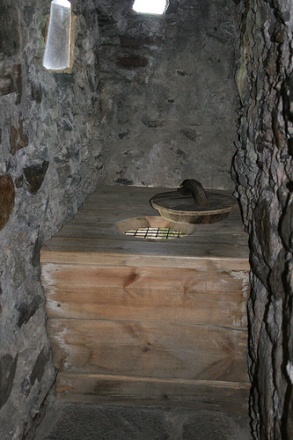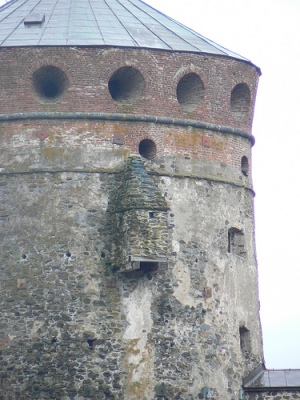

Location: Savonlinna, Southern Savonia Map
Erected: 1475
Olavinlinna Castle or Saint Olaf's Castle is located in Savonlinna,
Southern Savonia in Finland. Despite its untraditional look
Olavinlinna Castle was far from merely a aesthetically pleasant
citadel. Sweden and Novgorod Republic (one of many Russian
principalities) divided Finland in separate areas according to
Orechovec Peace Treaty of 1323. However the borders were not carved
in stone and both sides intruded on each others possessions. This
had to stop and in 1475 ruler of Vyborg Erik Axelsson Tott
constructed Olavinlinna Castle to draw a line of Swedish presence
here. He chose a small island between lakes Hankivesi and
Pinlajavesi for his future Olavinlinna fortress. Novgorod Russians
obviously were very unhappy with Swedish demarcation of the
fluctuating line, so they tried to sabotage the construction. This
included sinking of barges filled with building material, attacks on
construction camps of stone masons from Revel and many ways to slow
down or halt the erection of a new citadel.
Nevertheless was
quickly proved to be worth the effort and the money. Having
withstood Russian sieges in the First (1495- 97) when Olavinlinna
Castle was besieged twice by Moscow Prince Ivan III and Second
(1554-57) Russian- Swedish wars when it withstood siege with a
garrison of only 200 men it protected the claims in the region. With
the improvement of firepower Olavinlinna Castle became largely
obsolete. It was captured in 1714 by the Russians in the course of
the Northern War waged by the emperor Peter the Great and in 1743 it
fell to Russians again after just 2 days of siege. Finland became
part of the Russian Empire in 1809 and Olavinlinna Castle held a
small garrison of Russian troops until 1850 when it became a prison.
In 1860 it withstood two major fires and was abandoned. Only in 1912
reconstruction began that turned this romantic medieval citadel into
an arena for opera festivals held here from 1912 to 1917 and again
revived after 1967. Today Olavinlinna Castle become a scene for
theater for drama, ballet and other forms of art.
Finish military know how


As you enter Olavinlinna Castle you might wondering what is the purpose of this strange thing hanging on the side of one of the towers. It's the toilet. Did you ever try to climb up a wall covered in human feces? It must be pretty hard and unpleasant. Finish engineers thought so too and added this minor detail to add insult to the injury to anyone who tried to take Olavinlinna Castle.
Background
At the end of the 14th
century, Norway, Denmark and Sweden formed the Kalmar Union. Its
most important enemy was the Republic of Novgorod. The Union of
Kalmar had concluded peace and ceasefire agreements with Novgorod,
but the Principality of Moscow, led by Ivan III, also posed a
military threat to Finland. Since in the peace of Pähkinäsaari the
border line had been drawn along the Kyrönsalmi and Haukivesi
waterways on the eastern border of the Juva parish, in Eastern
Finland there was only Vyborg Castle to secure the Union's defense.
It was decided to build a new defensive fortress on the eastern
border, which was also intended to control the waterways in the
area. It was decided to build the castle on the rocky island of
Kyrönsalmi, collected from the fields and lands of the Juva
Administrative Parish, founded on 19 January 442. It was chosen
because it was completely surrounded by water and a strong flow of
water prevented freezing.
Building a castle
Construction
work on the main castle began in 1475. At that time, the castle lord
was Eerik Akselinpoika Tott, who had become acquainted with castle
architecture in Central Europe. 16 masons were brought from Tallinn
to manage the construction work. The working people are nearby
residents who paid their taxes by doing work. They also had to bring
building materials such as stones and logs to the castle. The
Russians are trying to disrupt the construction work, as they
claimed the castle was on their side of the border. Because of the
Russians, it was first necessary to build wooden protective
equipment and the construction work was protected by soldiers. Tott
decided to name the castle after St. Olaf. King St. Olavi of Norway
is the patron saint of all knights. Three towers came to the built
main castle, one of which had an alarm clock. When the construction
of the main castle was completed around 1485, the construction of
the forecourt began. The construction of the forecourt was completed
in the late 15th century. When completed, the castle, with its round
towers, represented the best defense technology of its time.
Defensive castle
The old anger broke out in 1495, when
Olavinlinna was also the first to be attacked. Before the war, the
Russians offered 5 to 10 years of peace and the extradition of
Olavinlinna to them. The defense of Olavinlinna was the
responsibility of Pietari Kylliäinen, who had 150 nieks and peasants
at his disposal. In total, the Russians made three attacks on
Olavinlinna during the old hatred, but were not allowed to take it.
After the war, border disputes continued, ending in 1510.
Gustav Vaasa, who became Swedish ruler in 1523, ordered Olavinlinna
to be repaired and improved. The towers of the main castle were
raised and a new large artillery tower was built in the forecourt.
Gustav Vaasa sent Henrik von Cöllen to lead the construction work.
The tower was completed in 1565. At the same time, the castle walls
were strengthened. In the 16th and 17th centuries, the Kijli Tower,
wooden living quarters, a commandant’s building, a sauna, workshop
and warehouse buildings were built. In 1577, Peter Hertig was the
master builder. During the same centuries, Olavinlinna was the
subject of several acts of war. After the Stolbova peace, Sweden's
eastern border had moved considerably further east, making
Olavinlinna no longer a border fortress. In 1622, King Gustav II
Adolf of Sweden visited the castle after returning from military
expeditions in Poland. He was the only king to visit Olavinlinna.
With the construction of the castle, the city grew around it:
Savonlinna gained city rights in 1639. The castle was damaged in
1654 by a large fire.
The Great Northern War began in 1700.
This affected Olavinlinna so that it surrendered to the Russians in
1714. At the same time, the Russians demolished the tower of St.
Erik, leaving only the two lowest floors. The Peace of Uusikaupunki
in 1721 ended the war, after which Sweden also acquired the
Savonlinna area. In 1741, the war of hats began, which ended in the
Peace of Turku in 1743. At that time, Olavinlinna remained in
Russian territory. The Russians built bastions in the area of the
fortress. In 1788, a protective water canal was built in the castle,
because Finnish and Swedish snipers were able to easily kill water
seekers while besieging the castle. The new part of the castle was
named Suvorov's fortress, according to Alexander Suvorov. In 1791,
the Thick Tower was destroyed when a powder depot exploded. A Thick
Bastion was built in its place. The military significance of the
castle ended when Finland became the Grand Duchy of Finland in 1809.
The castle housed a garrison until 1847.
Subsequent use
After the Russians left the castle in 1847, the castle was left empty for a few years. After this, the castle served as a prison for a short time, but then it was left empty again. Between 1868 and 1869, there were two large fires in the castle, which destroyed almost all the original wooden parts of the castle. In the 1870s, the castle began to be renovated as a historical monument. In 1875, the 400th anniversary of the castle was celebrated, with speeches by J. V. Snellman and August Ahlqvist, among others. At the same time, trees were planted in the castle area. In 1912, the first Savonlinna Opera Festival was organized on the initiative of Aino Ackté. In 1961, a major restoration of the castle began, with the aim of restoring the castle as close as possible to its original appearance. In this case, among other things, planted trees that did not belong to the original castle were felled and the roots destroyed the walls. In 1974, a reversible pontoon bridge was built in the castle.
The main
axis of Olavinlinna is east-west. At the west end is the main castle
and at the east end a larger forecourt. The triangular main castle
has three towers. The wall between the northwest and south towers is
bent slightly in the middle. There is a shooting range at the
highest wall in the main castle wall. The main castle also has a
three-storey palace, the top floor of which is now called the Royal
Hall. On the ground floor there are warehouses, in the middle the
castle room. The forecourt is rectangular.
The castle today
has three towers: the church tower, the bell tower and the Kijli
tower, named after the castle’s commander Nils Pederinpoika Kijli.
The ruins of St. Erik's Tower are also in the area. The tower is
named after Erik St., who was the patron saint of Sweden. The church
tower has been called the Tower of the Blessed Virgin, and the bell
tower has been called the Tower of St. Olaf. The church tower has a
small Catholic chapel. The fifth tower, the Thick Tower, exploded in
a crash in the 18th century.
Tourist destination and events
Olavinlinna is a popular tourist destination open all year round.
Parties and occasions such as weddings can also be held in the
castle premises. In 2019, about 149,873 guests visited Olavinlinna.
The most famous event in Olavinlinna is the annual Savonlinna
Opera Festival. The first Opera Festival was organized on the
initiative of Aino Ackté in 1912. Ackté had visited the castle in
1907 at a festival where she understood the fine setting of the
castle for organizing an opera festival. After 1912, the festivities
were held in the following years 1913, 1914, 1916 and after that
there was a break until again in 1930 they were held once more, but
after that there was a break of 37 years. Since 1967, opera
festivals have been held annually. About 70,000 guests visit the
opera festival every year, about 10 percent of whom are foreigners.
Olavinlinna currently also hosts professional boxing events. By
August 2018, six televised Boxing Night boxing events have been held
there.
Savonlinna celebrates St. Olaf's Day on July 29. It is
also the birthday of the city. In this case, events will also be
organized in Olavinlinna. During Easter week, an Easter play is
presented in the castle courtyard.
In the city's popular
culture
Olavinlinna and related legends have served as
inspiration for Robert Southey’s poem Donica.
In 1935, V.
Makkonen wrote the historical novel Savon Kupias Pietari Kylliäinen
about the early stages of Olavinlinna.
Olavinlinna is one of the
role models of Kropow Castle, which appears in 1938 in the album
King Ottokari's scepter about the adventures of the Belgian cartoon
character Tint.
The song Balladi from Olavinlinna, written by
Sauvo Puhtila and composed by Erkki Melakoski, has been performed by
Annikki Tähti in 1956, among others.
The castle is an important
setting in the secret police novel Black Fish, written by Eeva
Tenhunen in 1964.
The castle appears in Montreux's Golden
Rose-winning entertainment program Snow Castle, filmed there in
1965, in Spede Pasanen's film The Remains of the North from 1969,
and in the children's program Adventure in Olavinlinna, which dates
from 1978.